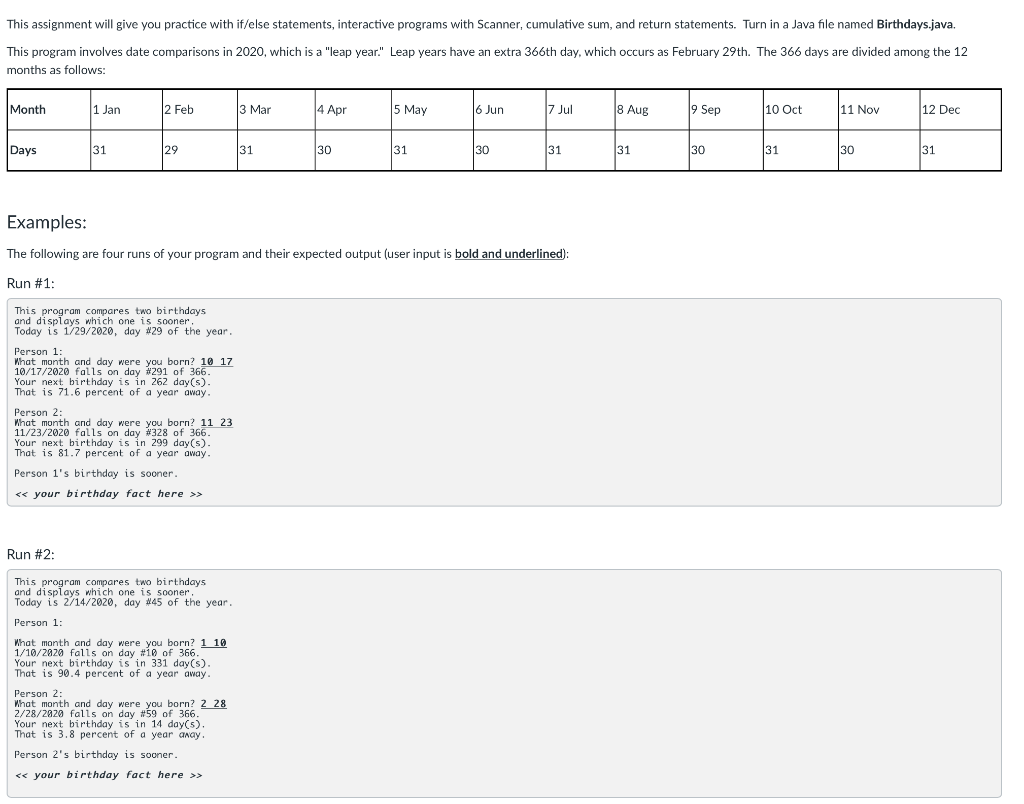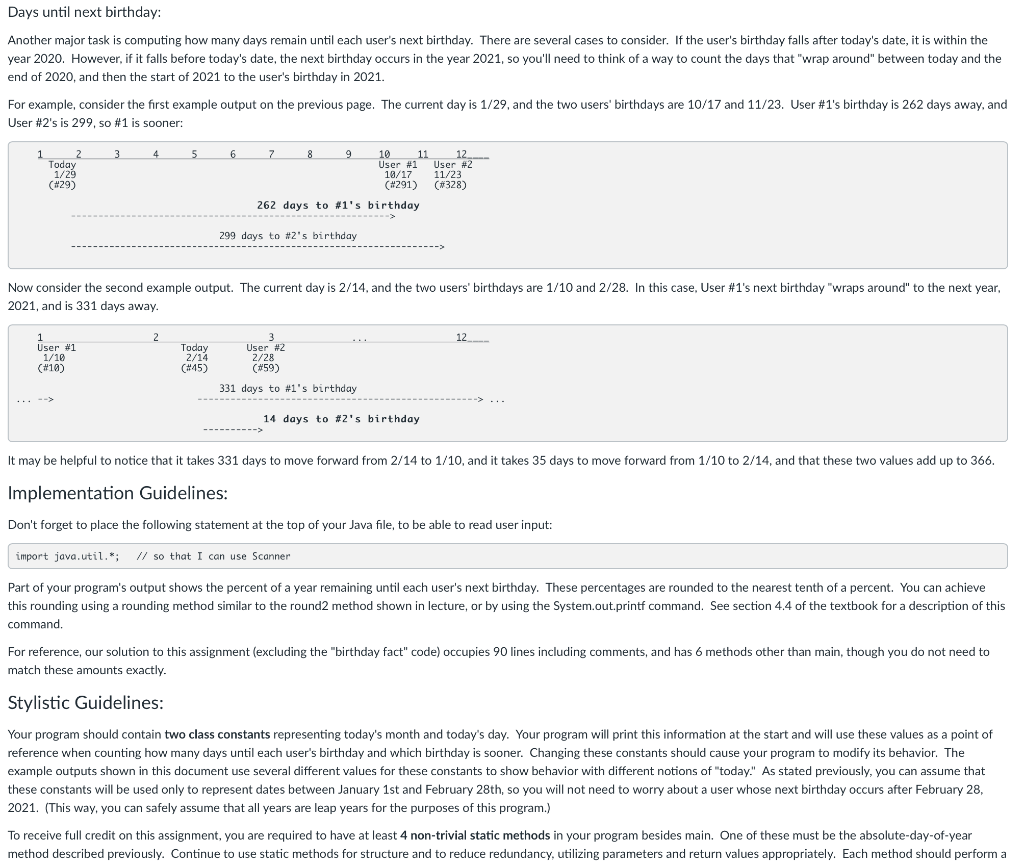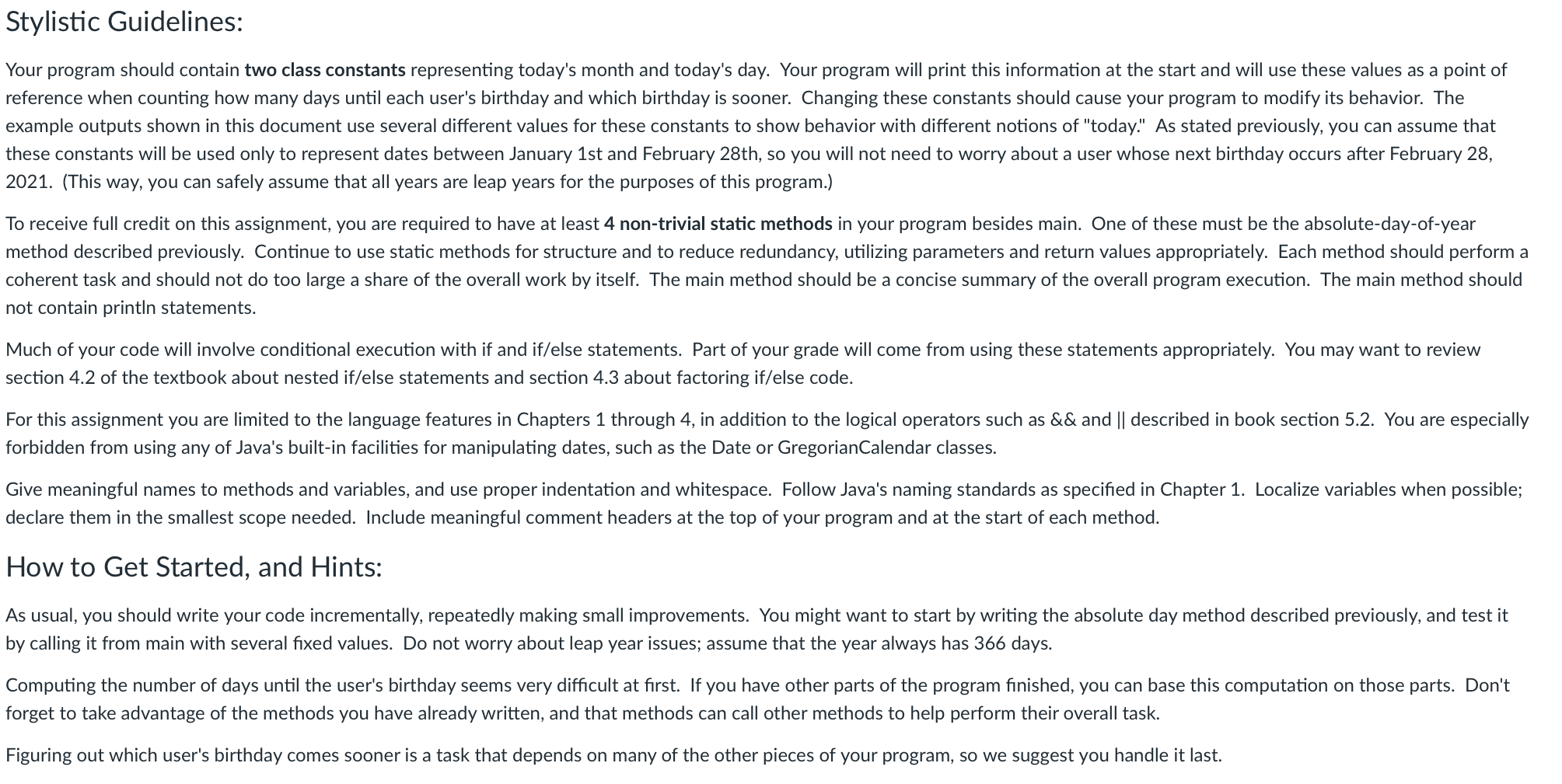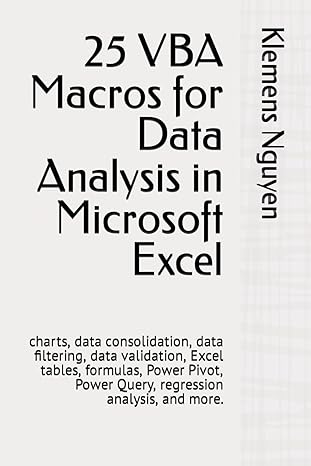



 One assignment, interactions are long had to break up pictures to get clear image. Should be done in Java language.
One assignment, interactions are long had to break up pictures to get clear image. Should be done in Java language.
This assignment will give you practice with if/else statements, interactive programs with Scanner, cumulative sum, and return statements. Turn in a Java file named Birthdays.java. This program involves date comparisons in 2020, which is a "leap year." Leap years have an extra 366th day, which occurs as February 29th. The 366 days are divided among the 12 months as follows: Month 1 Jan 2 Feb 3 Mar 4 Apr 5 May 6 Jun 7 Jul 8 Aug 19 Sep 10 Oct 11 Nov 12 Dec Days 31 29 31 30 31 30 31 31 30 31 30 31 Examples: The following are four runs of your program and their expected output (user input is bold and underlined): Run #1: 1 This program compares two birthdays and displays which one is sooner. Today is 1/29/2020, day #29 of the year. Person 1: What month and day were you born? 10 17 10/17/2020 falls on day #291 of 366. Your next birthday is in 262 days) That is 71.6 percent of a year away. Person 2: What month and day were you born? 11 23 11/23/2020 falls on day #328 of 366. Your next birthday is in 299 day(s). That is 81.7 percent of a year away. Person l's birthday is sooner. > Run #2: This program compares two birthdays and displays which one is sooner, Today is 2/14/2020, day #45 of the year. Person 1: What month and day were you born? 1 10 1/10/2020 falls on day #10 of 366 Your next birthday is in 331 day(s) That is 90.4 percent of a year away. Person 2: What month and day were you born? 2 28 2/28/2920 falls on day #59 of 366. Your next birthday is in 14 day(s). That is 3.8 percent of a year anay. Person 2's birthday is sooner. > Run #3: This program compares two birthdays and displays which one is sooner. Today is 1/1/2020, day #1 of the year. Person 1: What month and day were you born? 1 1 1/1/2020 falls on day #1 of 366. Happy birthday! Person 2: What month and day were you born? 12 31 12/31/2020 falls on day #366 of 366. Your next birthday is in 365 day(s). That is 99.7 percent of a year away, Person 1's birthday is sooner, > Run #4: This program compares two birthdays and displays which one is sooner. Today is 2/28/2020, day #59 of the year, Person 1: What month and day were you born? 2 29 2/29/2020 falls on day #60 of 366 Your next birthday is in 1 day(s). That is 0.3 percent of a year away Person 2 What month and day were you born? 2 29 2/29/2020 falls on day #60 of 366, Your next birthday is in 1 day(s). That is 0.3 percent of a year away. Wow, you share the same birthday! > Program Details: Your program asks for two users' birthdays and prints information about them. The program prompts for the birthday month and day of the two users. For both birthdays, the program prints the absolute day of the year on which that birthday falls, the number of days until the user's next birthday, and the percentage of a year (percentage of 366 days) away. Next the program shows which user's birthday comes sooner in the future. If it is a user's birthday today, or if the two birthdays are the same, different messages are printed. Lastly, the program prints a fun fact about your own birthday. Try searching Wikipedia and Google for interesting facts about your date of birth. For example, if yours is Sep. 19, you could print the following fact: Did ye know? 9/19 be International Talk like a Pirate Day, Arr, me mateys, arr! Since this is an interactive program, it behaves differently when given different input. The examples above may not show all possible cases. Please examine all example outputs on the web site and do your own testing, You may assume that all user input is valid, and that the program is being run between 1/1/2020 and 2/28/2020. Program Details: Your program asks for two users' birthdays and prints information about them. The program prompts for the birthday month and day of the two users. For both birthdays, the program prints the absolute day of the year on which that birthday falls, the number of days until the user's next birthday, and the percentage of a year (percentage of 366 days) away. Next the program shows which user's birthday comes sooner in the future. If it is a user's birthday today, or if the two birthdays are the same, different messages are printed. Lastly, the program prints a fun fact about your own birthday. Try searching Wikipedia and Google for interesting facts about your date of birth. For example, if yours is Sep. 19, you could print the following fact: Did ye know? 9/19 be International Talk like a Pirate Day Arr, me mateys, arr! Since this is an interactive program, it behaves differently when given different input. The examples above may not show all possible cases. Please examine all example outputs on the web site and do your own testing. . You may assume that all user input is valid, and that the program is being run between 1/1/2020 and 2/28/2020. Absolute day of the year: One major task in this program is computing the absolute day of the year on which each user's birthday falls in 2020. Jan 1 is day #1. Jan 2 is #2. Jan 31 is #31. Feb 1 is #32. And so on, up to Dec 31, which is #366. , Date (month/day) 1/1 1/2 1/3 1/31 2/1 2/2 -- 2/28 |2/29 3/1 HI! 3/2 12/30 12/31 HI! F Absolute day 1 12 3 ... 31 32 33 59 60 61 61 365 366 You must compute absolute days of the year by writing a particular static method. For reference, the following are the absolute days for the first day of each month. 1/1 2/1 3/1 4/1 5/1 6/1 7/1 8/1 9/1 10/1 11/1 12/1 Absolute day 1 32 61 92 122 153 183 214 245 275 306 336 NOTE: Your method to compute the absolute days in the year should never return / use these values directly. Instead, your 'absolute day' method must use a 'cumulative sum' approach that involves adding up the relevant months one at a time. This table is here just to help you test/double-check that your code is working correctly. You can type a date into your program (say, June 2nd) and then check that your program produces 154 as the answer (June 1st is 153 from the table below, plus 1 more day for June 2nd). This method should accept parameters representing a month and day and should return the absolute day of the year 2020 that is represented by those parameters. For example, calling this method with the parameter values of 2 and 13 (representing February 13th, 2020) should return 44, and calling it with parameter values of 9 and 19 (representing September 19th, 2020) should retum 263. This method should not produce any console output, though the result it returns can be printed by code elsewhere in your program. Your method must compute its value using a cumulative sum as described in section 4.1 of the textbook. To perform this calculation, you will also need code to evaluate the number of days in each particular month. You should put this code into a method that accepts a month parameter and returns the number of days in that month. Days until next birthday: Another major task is computing how many days remain until each user's next birthday. There are several cases to consider. If the user's birthday falls after today's date, it is within the year 2020. However, if it falls before today's date, the next birthday occurs in the year 2021, so you'll need to think of a way to count the days that "wrap around" between today and the end of 2020, and then the start of 2021 to the user's birthday in 2021. For example, consider the first example output on the previous page. The current day is 1/29, and the two users' birthdays are 10/17 and 11/23. User #1's birthday is 262 days away, and User #2's is 299, so #1 is sooner: 1 3 4 5 5 6 6 7 8 8 9 2 Today 1/29 (#29) 10 11 12 User #1 User #2 10/17 11/23 (#291) (328) 262 days to #1's birthday 299 days to #2's birthday Now consider the second example output. The current day is 2/14, and the two users' birthdays are 1/10 and 2/28. In this case, User #1's next birthday "wraps around" to the next year, 2021, and is 331 days away. 2 12 1 User #1 1/10 (#10) Today 2/14 (#45) 3 User 12 2/28 (#59) 331 days to #1's birthday 14 days to #2's birthday ---------> It may be helpful to notice that it takes 331 days to move forward from 2/14 to 1/10, and it takes 35 days to move forward from 1/10 to 2/14, and that these two values add up to 366. Implementation Guidelines: Don't forget to place the following statement at the top of your Java file, to be able to read user input: import java.util.*; // so that I can use Scanner Part of your program's output shows the percent of a year remaining until each user's next birthday. These percentages are rounded to the nearest tenth of a percent. You can achieve this rounding using a rounding method similar to the round2 method shown in lecture, or by using the System.out.printf command. See section 4.4 of the textbook for a description of this command. For reference, our solution to this assignment (excluding the "birthday fact" code) occupies 90 lines including comments, and has 6 methods other than main, though you do not need to match these amounts exactly. Stylistic Guidelines: Your program should contain two class constants representing today's month and today's day. Your program will print this information at the start and will use these values as a point of reference when counting how many days until each user's birthday and which birthday is sooner. Changing these constants should cause your program to modify its behavior. The example outputs shown in this document use several different values for these constants to show behavior with different notions of "today." As stated previously, you can assume that these constants will be used only to represent dates between January 1st and February 28th, so you will not need to worry about a user whose next birthday occurs after February 28, 2021. (This way, you can safely assume that all years are leap years for the purposes of this program.) To receive full credit on this assignment, you are required to have at least 4 non-trivial static methods in your program besides main. One of these must be the absolute-day-of-year method described previously. Continue to use static methods for structure and to reduce redundancy, utilizing parameters and return values appropriately. Each method should perform a Stylistic Guidelines: Your program should contain two class constants representing today's month and today's day. Your program will print this information at the start and will use these values as a point of reference when counting how many days until each user's birthday and which birthday is sooner. Changing these constants should cause your program to modify its behavior. The example outputs shown in this document use several different values for these constants to show behavior with different notions of "today." As stated previously, you can assume that these constants will be used only to represent dates between January 1st and February 28th, so you will not need to worry about a user whose next birthday occurs after February 28, 2021. (This way, you can safely assume that all years are leap years for the purposes of this program.) To receive full credit on this assignment, you are required to have at least 4 non-trivial static methods in your program besides main. One of these must be the absolute-day-of-year method described previously. Continue to use static methods for structure and to reduce redundancy, utilizing parameters and return values appropriately. Each method should perform a coherent task and should not do too large a share of the overall work by itself. The main method should be a concise summary of the overall program execution. The main method should not contain println statements. Much of your code will involve conditional execution with if and if/else statements. Part of your grade will come from using these statements appropriately. You may want to review section 4.2 of the textbook about nested if/else statements and section 4.3 about factoring if/else code. For this assignment you are limited to the language features in Chapters 1 through 4, in addition to the logical operators such as && and || described in book section 5.2. You are especially forbidden from using any of Java's built-in facilities for manipulating dates, such as the Date or GregorianCalendar classes. Give meaningful names to methods and variables, and use proper indentation and whitespace. Follow Java's naming standards as specified in Chapter 1. Localize variables when possible; declare them in the smallest scope needed. Include meaningful comment headers at the top of your program and at the start of each method. How to Get Started, and Hints: As usual, you should write your code incrementally, repeatedly making small improvements. You might want to start by writing the absolute day method described previously, and test it by calling it from main with several fixed values. Do not worry about leap year issues; assume that the year always has 366 days. Computing the number of days until the user's birthday seems very difficult at first. If you have other parts of the program finished, you can base this computation on those parts. Don't forget to take advantage of the methods you have already written, and that methods can call other methods to help perform their overall task. Figuring out which user's birthday comes sooner is a task that depends on many of the other pieces of your program, so we suggest you handle it last




 One assignment, interactions are long had to break up pictures to get clear image. Should be done in Java language.
One assignment, interactions are long had to break up pictures to get clear image. Should be done in Java language.





